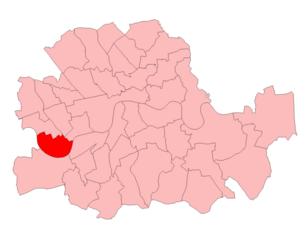Fulham (UK Parliament constituency) facts for kids
Quick facts for kids {{{Name}}}[[{{{Type}}} constituency]] |
|
|---|---|
| [[Image:{{{Map1}}}Constituency.svg|120px|]] [[Image:England{{{Map2}}}.svg|120px|]] |
|
| {{{Name}}} shown within [[{{{Entity}}}]], and {{{Entity}}} shown within England | |
| Created: | {{{Year}}} |
| MP: | {{{MP}}} |
| Party: | {{{Party}}} |
| Type: | House of Commons |
| County: | [[{{{County}}}]] |
| EP constituency: | [[{{{EP}}} (European Parliament constituency)|{{{EP}}}]] |
Fulham was a special area in London that elected a person to represent it in the House of Commons. The House of Commons is part of the Parliament of the United Kingdom, where laws are made for the country.
The Fulham area was a "constituency" (a voting area) for two main periods. First, from 1885 until 1918. Then, after a break, it was a constituency again from 1955 to 1997.
Between 1918 and 1955, the Fulham area was split into two smaller voting areas: Fulham East and Fulham West. When the Fulham constituency was abolished in 1997, it was replaced by a new area called Hammersmith and Fulham.
Contents
History of the Fulham Constituency
The Fulham constituency had an interesting journey through British politics. It was first created in 1885, allowing people in Fulham to choose their own Member of Parliament (MP). An MP is a person elected to speak for their local area in Parliament.
After 1918, the area was divided into two separate constituencies. This meant that instead of one MP for all of Fulham, there were two MPs, each representing a different part. This change lasted for many years.
Then, in 1955, the original Fulham constituency was brought back together. It continued to elect one MP until 1997. At that point, the political map changed again, and Fulham became part of a new, larger constituency.
Understanding Fulham's Boundaries
The "boundaries" of a constituency are like its invisible borders. They show exactly which streets and neighborhoods belong to that voting area. These boundaries can change over time, usually to make sure each constituency has roughly the same number of voters.
Boundaries from 1885 to 1918
During this first period, the Fulham constituency covered the entire area known as the parish of Fulham. This was a clear and simple boundary.
Boundaries from 1955 to 1974
When the constituency was re-established, its boundaries were based on specific parts of the Metropolitan Borough of Fulham. These parts were called wards, and they included Hurlingham, Munster, Sands End, Town, and Walham.
Boundaries from 1974 to 1983
The boundaries changed again in 1974. This time, the constituency included several wards from the London Borough of Hammersmith. These were Avonmore, Colehill, Crabtree, Gibbs Green, Helford, Margravine, Parsons Green, Sandford, Sherbrooke, Sulivan, and Town.
Boundaries from 1983 to 1997
For its final period, the Fulham constituency's boundaries were adjusted once more. It included wards from the London Borough of Hammersmith and Fulham: Avonmore, Colehill, Crabtree, Eel Brook, Gibbs Green, Margravine, Normand, Palace, Sands End, Sherbrooke, Sulivan, Town, and Walham.
Members of Parliament for Fulham
A Member of Parliament (MP) is the person elected by the people in a constituency to represent them in the House of Commons. They speak up for their local area and help make decisions about laws and how the country is run.
MPs from 1885 to 1918
| Election | Member | Party | |
|---|---|---|---|
| 1885 | William Fisher | Conservative | |
| 1906 | Timothy Davies | Liberal | |
| 1910 | William Fisher | Conservative | |
| 1918 | constituency abolished: see Fulham East and Fulham West | ||
MPs from 1955 to 1997
| Election | Member | Party | |
|---|---|---|---|
| 1955 | Michael Stewart | Labour | |
| 1979 | Martin Stevens | Conservative | |
| 1986 by-election | Nick Raynsford | Labour | |
| 1987 | Matthew Carrington | Conservative | |
| 1997 | constituency abolished: see Hammersmith and Fulham | ||
Election Highlights
Elections are how people choose their MPs. In the Fulham constituency, voters went to the polls many times to decide who would represent them. The results show which political party was most popular in Fulham at different times.
Early Elections (1880s-1910s)
In the early years, the Fulham constituency often voted for the Conservative Party. William Fisher was a very popular Conservative MP for Fulham, winning several elections. However, in 1906, the Liberal Party candidate, Timothy Davies, won the seat, showing a shift in local support. William Fisher won it back for the Conservatives in 1910.
Mid-Century Elections (1950s-1970s)
When the Fulham constituency was re-established in 1955, the Labour Party became very strong there. Michael Stewart was the Labour MP for Fulham for many years, winning multiple elections. He was a long-serving representative for the area.
Later Elections (1970s-1990s)
In 1979, the Conservative Party won the Fulham seat with Martin Stevens. This showed a change in how people were voting in Fulham. There was also a special election, called a "by-election," in 1986, which was won by Nick Raynsford for the Labour Party. However, the Conservatives won the seat back in the general election of 1987 with Matthew Carrington, who held it until the constituency was abolished in 1997.
Images for kids








